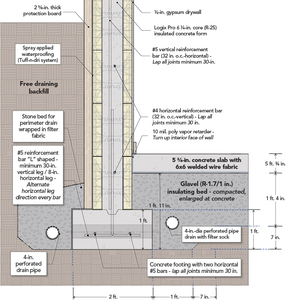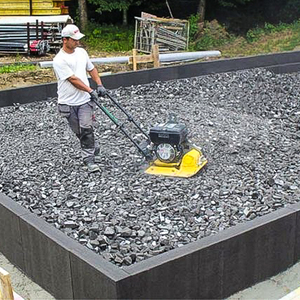
Foamed glass aggregate is gaining traction among high performance–home builders. It is touted for its ability to perform multiple functions and is used in residential applications for insulating slabs and as backfill. Ben Bogie, project manager for the build GBA is following, is partial to AeroAggregate but Glavel is another reputable supplier. Made from 100% recycled container glass, the product is ultra-lightweight, non-leaching, rot-resistant, durable, and low in upfront carbon emissions. It is easy to compact, has a respectable insulating value (12 in. of the material ranges from R-11.5 to R-15.7), and is highly permeable. Costs run between $70 and $80 per cu. yd. (AeroAggregate supplies 2.7-cu.-yd. bags.) Ben says the cost pencils out to close to even with foam board.
Installing foamed glass aggregate
On this project, the crew started the foamed glass installation at the bottom of the footing. The as-built detail above reflects a lowered elevation for the foamed glass—a response to the decision to create more headroom in the crawlspace, which will measure 4-ft. 6-in. in height and house the mechanicals.
The material goes down in 6-in. lifts, and each lift is compacted. There is a compaction factor based on the application and R-value objective. In this case, it was 1.37, which means if you put down 1.37 in. of product, the ideal compaction is to an inch. Here, they laid down 7 to 8 in., then compacted down to about 6 in., adding subsequent lifts.
Before the foundation walls go in, the compacted aggregate sits flush with the top of the footing, providing a flat surface for the crew to set the foundation walls. Once the walls are in place, they add another 6 in. of foamed glass for a total of 18 in. For the top inch, they use 3/4-in.-minus AeroAggregate, compacted and top-dressed with sand. (Because there is no concrete slab nor a plywood cover, the final surface needs to be as smooth as possible to receive a vapor barrier, which is the only material going over the aggregate.)
For installation, two or three bags are lifted with a forked loader and moved to where the excavator is sitting. The operator swings them into position, one at a time. The bottom of the bag is cut open and the operator works to evenly distribute the material throughout the foundation. Then it is hand-graded and machine-compacted.
A multi-functional product
Asked why Ben is sold on foamed glass (he has used it on a few projects), he says, “It’s a waste-stream product with a low EUI, and with it we can accomplish multiple things in one process. Normally, we’d have to do the foundation prep, excavation, and footings, followed by 6 in. of washed stone, which comes at an additional cost. That is replaced with the foamed glass aggregate. This way, we have our drainage, moisture, and insulation completely handled by one product.”
______________________________________________________________________
Kiley Jacques is senior editor at Green Building Advisor. Illustration by Patrick Welsh. Photos by Brian McAward.
Weekly Newsletter
Get building science and energy efficiency advice, plus special offers, in your inbox.















14 Comments
Interesting stuff! I hope it becomes more commonly available. What was it like to run services through?
Malcolm, I think you would enjoy the BS* + Beer Show episode on this topic--it’s super informative and features reps from both Glavel and AeroAggregate.
Thanks Kiley. That looks like a great way to spend what looks to be shaping up as be a rainy evening.
Used it in a basement underpinning project. Laid the plumbing prior to installing Glavel. So it was easy that way?
With both AeroAggregate and Glavel now operating plants in North America, these materials are becoming far more accessible. Glavel's first plant is in Burlington, VT, conveniently close to me. Glavel is also importing foamed glass boards and is planning to produce that also within the next year or so. AeroAggregate has several plants in N.A., on the west coast and southeast. Looking forward to using it on my next project.
Had some shipped to me in Hamilton Ontario. Cost of shipping was more than materials, and install was a huge pain in my specific situation, but would do it again (and will in next project).
Would foamed glass aggregate with adequate drainage work as the horizontal insulation for a frost-protected shallow foundation, or does that application need impermeable insulation sheets? I love the idea of foamed glass below grade -- it's not going to be bothered by critters, and since it's just glass (processed sand / minerals) it's not just burying plastic for future generations.
I think it would work really well as far as performing both functions. My only concern would be that it might fill with silt eventually, and that that would reduce the R-value, at least to some extent. That effect could be reduced by using a geotextile fabric over it, but perhaps the boards would be better.
I see that Glavel is committed to running their energy-intensive process with renewable energy, but I don't see any such statement from AeroAggegrate. The information from Glavel says that their emboddied energy is only 23% that of EPS ... on a per unit mass basis. On a per unit volume basis, that means the embodied energy would be 1.5 times that of 1.5 lb/cu ft EPS, or more than 3X that of EPS for the same R-value. For Glavel, that's not a problem--it seems like a nearly perfect low-impact material, recycling waste and without any emissions from the energy used in production. But it might be different for AeroAggregate.
Overall I love this approach--if we compare it to concrete, it's surely much lower emissions. But it is an energy intensive process, and if one manufacturer is powering that from renewables and the other from the standard grid mix, it might be important to pick the lower emission option. Or at least, if AeroAggregate wants to sell this as a material for low-carbon building, they should provide information on their carbon emissions.
You make an excellent point, Charlie, and I respect that you looked into it more deeply. Clearly, there are questions that need answering on that front. Recently, I was talking with the manufacturer of Croft compressed-straw wall and roof panels and he made the same essential point, which boils down to: If the production process is energy-intensive, then the product really isn't solving any problems.
That's a great observation, Kiley and one of the reasons that I don't love rockwool or FG insulation. They're more climate-friendly than most polymer foams, but still use lots of energy to make. We need better tools to analyze the total installed carbon cost of our material choices. In the case of these foamed glass aggregates, they take the place of the washed gravel layer and the foam insulation layer. So we have to compare the carbon costs (cradle to gate) of all three material layers. The foamed aggregates do use a lot of energy for manufacture, but they are lightweight and so, they reduce the transportation energy compared to washed gravel. Then we have the carbon related to mining, distance traveled, etc. With the new, low-carbon Glavel plant in VT, using it here in-state seems like a no-brainer. But how does that compare to locally mined gravel in the midwest and not near any of the plants? FWIW, the new BEAM carbon calculator tool is a great start, but still only captures the carbon cost of materials with published EPD's.
I'm (homeowner) considering using the foamed glass aggregate (FGA) as the crushed stone footing for the Superior Wall precast concrete foundation wall system (https://www.superiorwalls.com/about-superior-walls/superior-walls-process/) for my new construction single family house.
Also, the foamed glass aggregate would be continuously installed under the slab providing both the subbase and basement slab insulation. In addition, the FGA could wrap around and up the exterior to reduce thermal transfer thru the foot of the wall.
Has anyone seen the FGA used in this type of application? Any comments are or concerns are very welcomed.
I’ve reached out to Superior Walls for their comments but haven’t heard back yet.
I see no reason that this would be a problem. According to the manufacturers, the FGA can be used as a direct replacement for washed gravel, pretty much anywhere.
Could you take the method presented in this diagram and put a floating floor on top? That is, two layers of cross laid flooring, glued and screwed? Seems like maybe something to prevent damage to the membrane would be necessary, but otherwise, it should work. I'm looking to put in a low carbon floor in a room that already doesn't have a slab
Log in or create an account to post a comment.
Sign up Log in